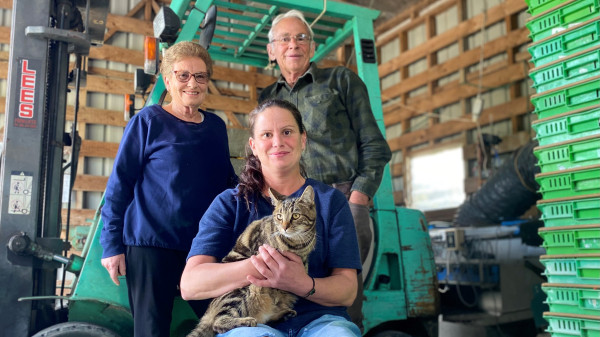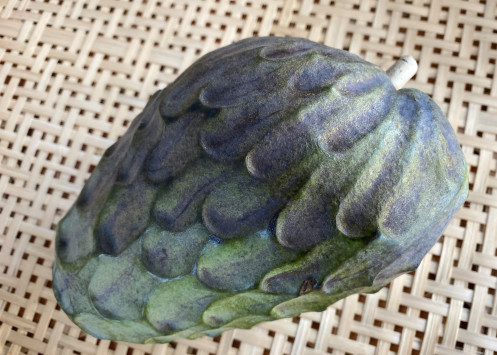The Greys bring century of history to growing
1 November 2022
More than a century after his grandfather planted the country's first avocados, Bruce Grey is conducting his own trials around how to get the most out of the unique – and sometimes challenging – cherimoya. KRISTINE WALSH reports.
There is an art to getting delicate cherimoya fruit to market in good condition and it's one Bruce and Marg (Margaret) Grey have mastered.

Having a small packhouse at their Waimarae Orchards means Marg and Bruce Grey (rear) can get both their cherimoyas, and those grown by their daughter Erin (front, with Missy the orchard cat) to market in a timely manner
The cherimoya is a member of the custard apple family, Annonaceae, which includes other tropical fruits such as paw paw, soursop and more. A large, aromatic fruit weighing up to a kilogram or more, cherimoya have a green skin, white creamy flesh and a wonderful flavour somewhere between that of a banana and a pineapple. Despite being native to Peru and Ecuador where conditions are mild, they are now grown successfully in warm, temperate areas of New Zealand.
The Greys say the key is to get the cherimoyas picked, packed and on the road in one day. And because consumers in Auckland buy them all within a day or two, they are getting fruit in premium condition.
With a small packhouse on their orchard at Ormond, just inland from Gisborne, Bruce and Marg have everything they need right at their fingertips.
It also means they can handle the cherimoyas that their daughter, Erin Grey, grows at her own property just half a kilometre down the road.
Together, all fruit is marketed under the Greys’ property name, Waimarae Orchards, one that is steeped in history.
It is located on the site of the original orchard of the same name where, in the 1920s, Bruce's grandfather, Charles Grey, germinated and planted the country's first avocados.
After World War II, three hectares were bought by the Land Settlement Board for a returned serviceman while Charles, and later his son Len, used the rest of the property to continue their pioneering avocado operation.
That was a tradition continued in the late 1960s by Bruce and his older brother David, who planted avocados on their own property at Bushmere, just seven kilometres up the road.
“Bruce sold his share to David so we could go into partnership with their parents, Len and Dorothy. In 1982 we were able to buy back the land that had been sold, to again make one big orchard,” Marg explains.
By the time Len Grey died in 1993 – followed by Dorothy 11 years later – Waimarae had become a 25-hectare orchard with a substantial packhouse operation. During this time, the Greys had seen their share of trouble.
“Because we are right on the Waipaoa River, Cyclone Bola (1988) was just about the end of us… none of the avocados survived, and kiwifruit in what we call the 'Ormond dip' completely disappeared under the water,” says Bruce. “We had to decide whether to treat it as a challenge, or just walk off the land and in the end, it was a challenge we were up for.”
The Greys rebuilt with a range of products from tamarillos – which did well until struck down by psyllid and a virus – to their main crop, feijoas.
In the early 2000s, Bruce and Marg purchased a two-hectare property just a couple of minutes away, pulling out the existing grapes. Meanwhile, their daughter Erin bought another two hectares just next door.
As time passed, they wanted to cut down on their workload, so they retained the two hectares they have up the road and downsized the original property to just over a hectare – complete with a small packhouse.
Bruce and Marg now have the perk of living in the home built for the returned serviceman back in the 1940s… renovated for modern living, of course.
“Between our total of three hectares and Erin's two, we have quite a production of feijoas, lemons, limes, lemonades and cherimoya,” says Marg. “And Erin has been in there, boots and all, in terms of working hard and being willing to grow everything from the cherimoya to blood oranges and finger limes. She's a Grey and they just can't help themselves.”
Marg says she too, is willing to muck in, whereas Bruce is more the driver behind innovation on the orchard.
“He never stops working and is so clever in working out new ways of doing things and thinking of new varieties to grow.”

Green and thin-skinned, when they are ready to eat, cherimoyas will soften and develop a coppery hue
The Greys' current plantings of cherimoya aren't their first. They originally worked with the trees Len had planted in the 1950s and 1960s, all lost to Cyclone Bola.
“Our growing of the new trees has been a lifetime project, a bit like Len with his avocados and David with the green-skin varieties he developed,” says Bruce.
Bruce has come up with his own cherimoya variety, Solo, which is planted alongside existing varieties including Reretai and Bayes.
The couple say that, even today, there is an element of experimentation with their hundreds of trees.
“We're continually trialling at all stages from rootstock and seedlings to pollination, fruit production and pruning,” Bruce says. “But we're glad we gave them another go.”
With their harvest starting in July and generally ending around October, this year Waimarae Orchards has shipped more than 4000 kilograms of cherimoya, mostly to Auckland, where Asian consumers in particular snap them up.
“They can be challenging, you certainly don't want them held up in a coolstore for a week,” Bruce says. “But they are in high demand so it's great to grow something people really love.”
